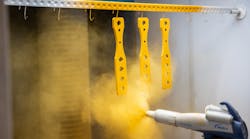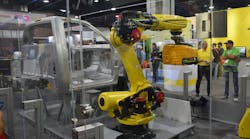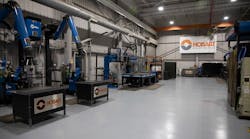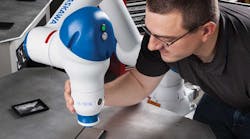Installing a robot to perform a job—even a dirty, repetitive, or dangerous job—may not be a good idea. Sometimes humans and robots should work together.
So says Keith Vozel, product manager with the Motoman Robotics Division of Yaskawa America, Inc.
“This may come as a surprise given what we do for a living, but installing an industrial robot to take over grimy or monotonous work may not always be the answer. That’s because not all robots are equal.”
Here are some reasons to take a close look at the job before reconfiguring the work:
• First, industrial robots can be a complex solution, especially for small and medium-sized businesses.
• Second, not every plant manager has the staff (or budget to hire an integrator) to program (and reprogram) a robot.
• Third, industrial robots require the robot’s working area to be safeguarded to prevent potential injury to humans.
“Depending on your application, you can overcome the above challenges by “hiring” a special type of industrial robot—a collaborative robot, or cobot,” Vozel says. “A cobot is relatively lightweight and designed to operate safely in close proximity to people. This can eliminate curtains or fencing through the use of sensors or force-limiting technology with the proper application and risk assessment. It’s also easily programmed through hand guiding, which allows a worker to move the cobot’s arm to each point in a job instead of typing commands into a pendant.”
Before manufacturers invest in a cobot, they should conduct a risk assessment, Vozel advises. Certified experts in robotics can evaluate current and planned operations to be sure that the robot, application, and humans interact safely.
“Getting this chemistry right ensures a safe place to work and an uptick in productivity,” he says.
Cobots are sometimes known as “fenceless robots.” The implication is that humans can work safely beside them.
“However, if you’re manufacturing knives with a fenceless robot, is a worker nearby any safer because the robot is moving slowly?” Vozel asks. “It’s all about evaluating the complete system.”
Collaborative robots can work alongside humans. They are designed to stop immediately if they come in contact with a human coworker. The result, Vozel says, is to minimize or even eliminate injury.
Cobots also are designed to quickly learn new tasks.
“If you decide to reconfigure your production line to handle a new product, a properly trained operator can reprogram a cobot in an hour or two,” Vozel says. “Compare that to the one or two days of production time lost reprogramming an industrial robot to handle a line changeover. For most plant managers, this last point alone makes a cobot worth the cost.
“In fact, collaborative robots are a way to future-proof your manufacturing process. If management wants to change the style or type of product its plants are running, a collaborative robot is versatile enough to handle whatever changeovers you want with minimal effort and time. Collaborative robots can provide benefits in terms of safety, cost, quality and ROI; thus, making them a feasible solution for the technical and economic challenges faced by supply chain organizations, no matter the industry or size.” ♦









